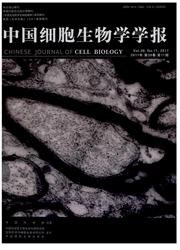

 中文摘要:
中文摘要:
肿瘤坏死因子α(tumor necrosis factor alpha,TNFα)诱导的L929细胞死亡是研究细胞程序性坏死的重要模型,但也有报道称,TNFα处理后的L929细胞发生了凋亡。该研究以所在实验室保存的L929细胞(L929-A)和从商业化细胞库购买的L929细胞(L929-N)为模型,进一步鉴定了TNFα诱导的L929细胞死亡类型与调控机制。结果发现,TNFα处理后的L929-A细胞中出现了凋亡特征,且阻断胱冬肽酶(caspase)信号通路可显著抑制TNFα诱导的L929-A细胞死亡,但却促进TNFα诱导的L929-N细胞死亡。此外,受体相互作用蛋白1(receptor-interacting protein 1,RIP1)在TNFα诱导的两种L929细胞死亡过程中都具有关键性的调控作用,表明TNFα处理后的L929-A细胞发生了RIP1依赖的细胞凋亡,而L929-N细胞发生了程序性坏死(necroptosis)。同时,启动细胞程序性坏死的关键蛋白RIP3(receptor-interacting protein 3)在L929-N细胞中表达水平显著高于L929-A细胞,因此,RIP3的这种差异表达可能是决定两种L929细胞在TNFα处理后发生不同类型细胞程序性死亡的重要原因。
 英文摘要:
英文摘要:
L929 cell death induced by tumor necrosis factor alpha (TNFα) has been identified as the well- established model of necroptosis, a new kind of programmed cell death. However, some other studies report that TNFα induces apoptosis but not necroptosis in L929 cells, so it is confused about the exact model of cell death in- duced by TNFα in L929 cells. In this research, we further explored L929 cell death and the involved mechanism in response to TNFα Two kinds of L929 cell lines were used in this study, and named L929-A cells (derived from our laboratory cell bank) and L929-N cells (derived from commercial cell bank), respectively. Many kinds of apoptotic characters have been detected in L929-A cells followed TNFα treatment, including DNA ladder and activation ofcaspase signaling pathway. Moreover, suppressing activation of caspase signaling pathway with pan caspase inhibi- tor or knockdown of caspase 8 almost completely blocked TNFα-induced L929-A cell death, but significantly pro- moted L929-N cell death induced by TNFα. In addition, cell death of L929-A and L929-N cells induced by TNFα was significantly inhibited by RiP 1 knockdown or RiP 1 inhibitor. Therefore, TNFct induces RIP 1-dependent apop- tosis in L929-A cells, but necroptosis in L929-N cells. In addition, RIP3 expression level in L929-N cells is signifi- cantly higher than that in L929-A cells. As RIP3 is a key target protein in initiating necroptosis, so it is reasonable that the differential expression of RIP3 in L929-A and L929-N cells contributes to the different programmed cell death in these two cell lines in response to TNFα treatment.
 同期刊论文项目
同期刊论文项目
 同项目期刊论文
同项目期刊论文
 期刊信息
期刊信息
